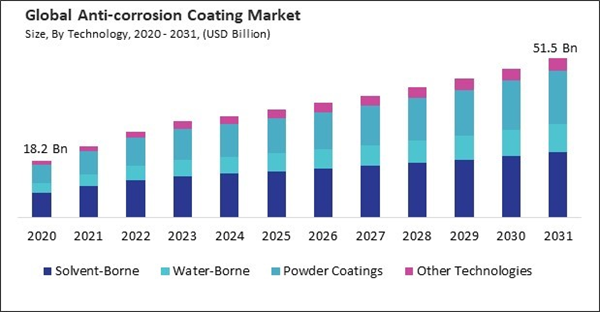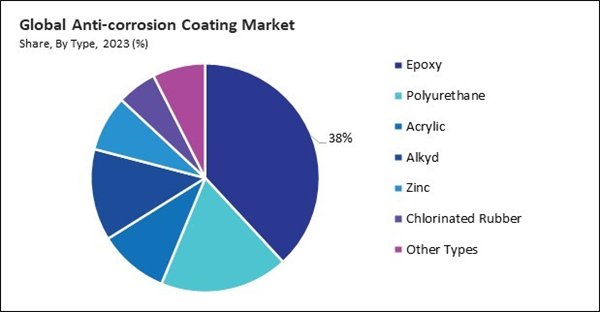The Global Anti-corrosion Coating Market size is expected to reach USD51.5 billion by 2031, rising at a market growth of 6.7% CAGR during the forecast period. In the year 2023, the market attained a volume of 10,859.7 kilo tonnes, experiencing a growth of 27.2% (2020-2023).
Polyurethane coatings offer superior abrasion resistance, making them suitable for applications where the coated surface is subjected to wear and tear, such as floors, decks, and transportation equipment. This helps maintain the integrity of the coating and prolong its service life even in high-traffic areas. Polyurethane coatings are known for their flexibility and durability, allowing them to withstand thermal expansion, contraction, and mechanical stress without cracking or peeling. This flexibility makes them ideal for use in environments with temperature fluctuations or dynamic loading conditions. Thus, the polyurethane segment covered 18% revenue share in the anti-corrosion coating market in 2023. In term of volume, 3,070.9 kilo tonnes of Polyurethane type anti- corrosion coatings is expected to be utilized by 2031.
Anti-corrosion coatings formulated for immersion and submersion applications provide corrosion protection for hydroelectric infrastructure, reducing maintenance requirements and extending service life. Therefore, the anti-corrosion coating market is expanding significantly due to the rapid growth in renewable energy infrastructure. Additionally, Innovations such as bio-based materials, renewable resources, water-based formulations, and low-energy curing processes offer opportunities to develop next-generation coatings that meet sustainability requirements without compromising performance. Thus, because of the growing demand for sustainable solutions, the anti-corrosion coating market is anticipated to increase significantly.
However, high initial investment costs can deter industries from adopting new anti-corrosion coating technologies or investing in unproven solutions. Risk-averse decision-makers may prefer to stick with conventional corrosion protection methods or delay investment decisions until the cost-effectiveness and reliability of new coating technologies are proven, slowing market adoption rates. Thus, the high initial investment can slow down the growth of the anti-corrosion coating market.
Polyurethane coatings offer superior abrasion resistance, making them suitable for applications where the coated surface is subjected to wear and tear, such as floors, decks, and transportation equipment. This helps maintain the integrity of the coating and prolong its service life even in high-traffic areas. Polyurethane coatings are known for their flexibility and durability, allowing them to withstand thermal expansion, contraction, and mechanical stress without cracking or peeling. This flexibility makes them ideal for use in environments with temperature fluctuations or dynamic loading conditions. Thus, the polyurethane segment covered 18% revenue share in the anti-corrosion coating market in 2023. In term of volume, 3,070.9 kilo tonnes of Polyurethane type anti- corrosion coatings is expected to be utilized by 2031.
Anti-corrosion coatings formulated for immersion and submersion applications provide corrosion protection for hydroelectric infrastructure, reducing maintenance requirements and extending service life. Therefore, the anti-corrosion coating market is expanding significantly due to the rapid growth in renewable energy infrastructure. Additionally, Innovations such as bio-based materials, renewable resources, water-based formulations, and low-energy curing processes offer opportunities to develop next-generation coatings that meet sustainability requirements without compromising performance. Thus, because of the growing demand for sustainable solutions, the anti-corrosion coating market is anticipated to increase significantly.
However, high initial investment costs can deter industries from adopting new anti-corrosion coating technologies or investing in unproven solutions. Risk-averse decision-makers may prefer to stick with conventional corrosion protection methods or delay investment decisions until the cost-effectiveness and reliability of new coating technologies are proven, slowing market adoption rates. Thus, the high initial investment can slow down the growth of the anti-corrosion coating market.
Driving and Restraining Factors
Drivers
- Rapid growth in renewable energy infrastructure
- Growing demand for sustainable solutions
- Increasing growth in the automotive sector
Restraints
- High initial investment in anti-corrosion
- Significant regulatory compliance challenges
Opportunities
- Emergence of nanotechnology-based coatings
- Increasing adoption of powder coatings
Challenges
- Lack of supply chain issues
- Adverse impact of environmental regulations
Type Outlook
By type, the market is categorized into epoxy, polyurethane, acrylic, alkyd, zinc, chlorinated rubber, and others. The alkyd segment acquired 13% revenue share in the market in 2023. Alkyd coatings are known for their ease of application and compatibility with various application methods, including brushing, rolling, and spraying. In terms of volume, 3,020.1 kilo tonnes of alkyd types of anti-corrosion coating is expected to be utilized by 2031.Technology Outlook
Based on technology, the market is classified into solvent-borne, water-borne, powder coatings, and others. In 2023, the solvent-borne segment witnessed 43% revenue share in the market. Solvent-borne coatings can be formulated to meet various performance requirements, including adhesion to various substrates, chemical resistance, and UV stability. In the terms of volume, 7,931.6 kilo tonnes of anti-corrosion coating is expected to utilize by solvent-borne technology by 2031.End Use Industry Outlook
On the basis of end use industry, the market is divided into marine, oil & gas, industrial, construction, energy, automotive, and others. In 2023, the marine segment dominated the market with 27% revenue share. Anti-corrosion coatings are essential for protecting the hulls and other metal components of ships from corrosion caused by exposure to seawater. In terms of volume, 3,595.2 kilo tonnes of anti-corrosion coating is expected to utilize in marine industry by 2031.Regional Outlook
Region-wise, the market is analysed across North America, Europe, Asia Pacific, and LAMEA. In 2023, the North America region acquired 22% revenue share in the market. In North America, particularly in regions with extensive oil and gas operations, such as the Gulf Coast, anti-corrosion coatings protect pipelines, storage tanks, refineries, and offshore platforms from corrosion caused by exposure to harsh environments, chemicals, and corrosive substances. In terms of volume, the North America region is expected to utilize 3,742.4 kilo tonnes of anti-corrosion coating by 2031.List of Key Companies Profiled
- The Sherwin-Williams Company
- 3M Company
- Hempel A/S
- PPG Industries, Inc.
- The Dow Chemical Company
- Kansai Paint Co., Ltd.
- Wacker Chemie AG
- BASF SE
- Akzo Nobel N.V.
- Nippon Paint Holdings Co., Ltd.
Market Report Segmentation
By Technology (Volume, Kilo Tonnes, USD Billion, 2020-2031)
- Solvent-Borne
- Water-Borne
- Powder Coatings
- Other Technologies
By Type (Volume, Kilo Tonnes, USD Billion, 2020-2031)
- Epoxy
- Polyurethane
- Acrylic
- Alkyd
- Zinc
- Chlorinated Rubber
- Other Types
By End Use Industry (Volume, Kilo Tonnes, USD Billion, 2020-2031)
- Marine
- Oil & Gas
- Industrial
- Construction
- Energy
- Automotive
- Others
By Geography (Volume, Kilo Tonnes, USD Billion, 2020-2031)
- North America
- US
- Canada
- Mexico
- Rest of North America
- Europe
- Germany
- UK
- France
- Russia
- Spain
- Italy
- Rest of Europe
- Asia Pacific
- China
- Japan
- India
- South Korea
- Australia
- Malaysia
- Rest of Asia Pacific
- LAMEA
- Brazil
- Argentina
- UAE
- Saudi Arabia
- South Africa
- Nigeria
- Rest of LAMEA
Table of Contents
Chapter 1. Market Scope & Methodology
Chapter 2. Market at a Glance
Chapter 3. Market Overview
Chapter 4. Global Anti-corrosion Coating Market by Technology
Chapter 5. Global Anti-corrosion Coating Market by Type
Chapter 6. Global Anti-corrosion Coating Market by End Use Industry
Chapter 7. Global Anti-corrosion Coating Market by Region
Chapter 8. Company Profiles
Companies Mentioned
Some of the key companies in the Anti-corrosion Coating Market include:- The Sherwin-Williams Company
- 3M Company
- Hempel A/S
- PPG Industries, Inc.
- The Dow Chemical Company
- Kansai Paint Co., Ltd.
- Wacker Chemie AG
- BASF SE
- Akzo Nobel N.V.
- Nippon Paint Holdings Co., Ltd.
Methodology

LOADING...










